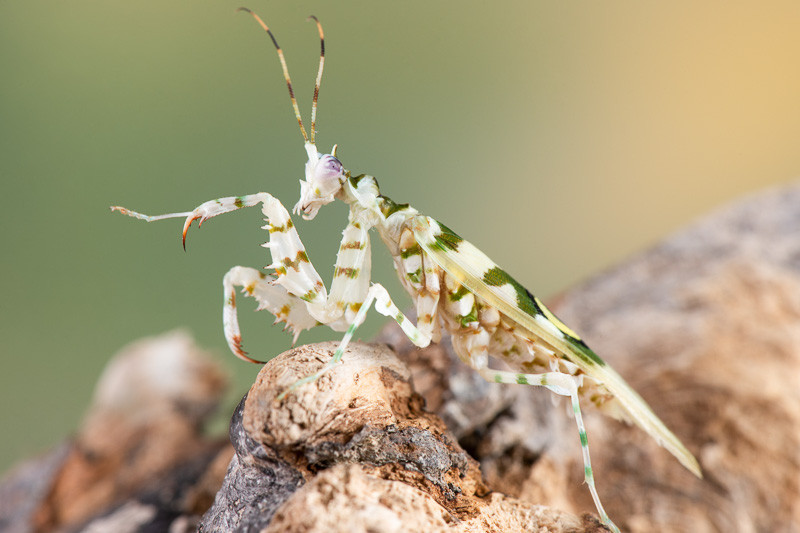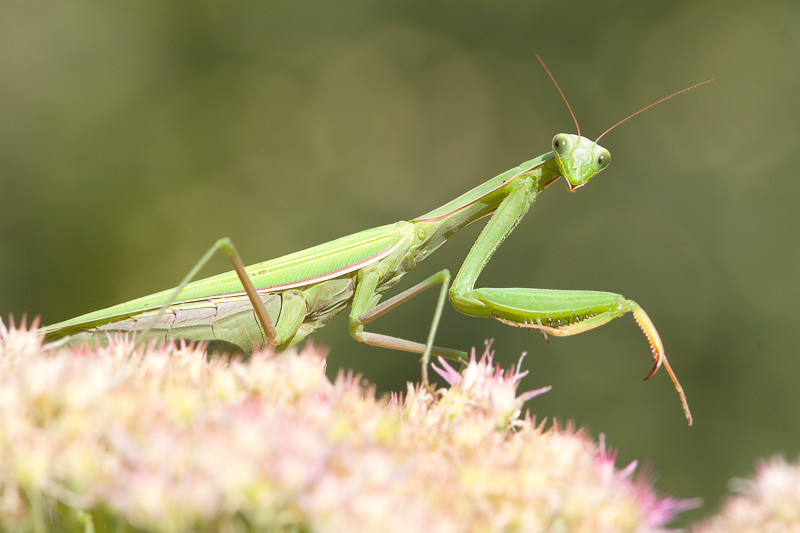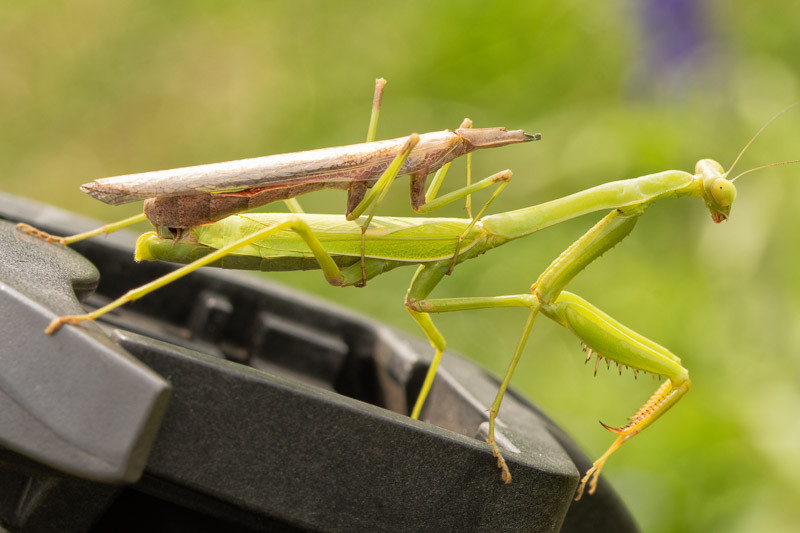Family Mantidae
Praying mantises are found in many regions around the world, with over 2,400 species known to exist. They are widely distributed and are found in a variety of habitats, from forests to deserts and grasslands.
The praying mantis gets its name from the way it holds its front legs in an upright, praying position. In Greek, “mantis” means “prophet” or “seer,” and the insect’s upright stance is said to resemble the posture of a praying person. The name “praying mantis” is used for this insect in many countries, including the United States, and has become a common name for the species.
Praying mantises are known for their ability to blend in with their surroundings and mimic the appearance of leaves and twigs. This helps them to avoid detection by potential predators and to ambush their prey more effectively. The intricate patterns and shapes on the praying mantis’ body, combined with its ability to hold still for long periods of time, make it one of the most formidable predators in the insect world.
Some species of African praying mantises have evolved to look like flowers or leaves to attract their prey, while others have evolved to look like twigs or bark to avoid being detected by predators. The camouflage is often so effective that the praying mantis can be difficult to see, even when it is in plain sight.
 Pseudocreobotra wahlbergii, or the spiny flower mantis, is a small flower mantis native to southern and eastern Africa
Pseudocreobotra wahlbergii, or the spiny flower mantis, is a small flower mantis native to southern and eastern Africa
Praying mantises have a 3D vision, which is quite unusual among insects. They have two large compound eyes that are highly sensitive to motion, and they use this ability to track and catch their prey. This 3D vision allows them to judge distances accurately and to perceive depth, making it easier for them to judge the position of their prey and strike with precision.

Mantises are skilled hunters, and they have a unique set of adaptations that allow them to be very effective at capturing their prey. Some of the key facts about the hunting abilities of mantises include:
These adaptations, along with their natural hunting instincts, make mantises highly effective hunters in the insect world.

Yes, praying mantises can fly. Although they are not strong fliers, they have the ability to fly short distances, glide, or hover in the air, especially to escape predators or to catch their prey. Their strong front legs and lightweight bodies allow them to make sudden, jerky movements and change directions quickly, making them effective hunters in their natural habitats.
Female praying mantises have been known to sometimes engage in cannibalism, eating their male partners after mating. This behavior is thought to be driven by a need for additional protein and nutrients to support egg production. However, not all female mantises engage in this behavior, and the frequency with which it occurs can vary depending on factors such as food availability and population density.
 Female Carolina Mantis with a dead, headless male still attached to her while mating. Female mantids bite the head off the males.
Female Carolina Mantis with a dead, headless male still attached to her while mating. Female mantids bite the head off the males.
Yes, praying mantises have the ability to rotate their heads 180 degrees, giving them an almost 360-degree view of their surroundings. This ability allows them to quickly spot and track prey, as well as to be aware of potential predators. The flexible neck and ability to rotate their heads is an adaptation that has evolved to help mantises hunt and survive in their environments.
Praying mantises lay their eggs in a protective foam called an ootheca. The foam provides a safe and secure environment for the developing eggs, which are vulnerable to predation and environmental factors. The ootheca also helps to regulate temperature and humidity levels, providing ideal conditions for the eggs to hatch. The foam hardens as it dries, creating a tough and durable protective casing that can last for months or even years, depending on the mantis species.
 Bernard DupontOptimized.jpg)
Praying mantises are beneficial insects because they feed on various pests in gardens and fields, including crickets, mites, mosquitoes, grasshoppers, and beetles, which helps to keep pest populations in check. They are also important predators of insects that damage crops, making them valuable allies for farmers and gardeners. Mantises have a voracious appetite and can consume large amounts of prey.
They play an important role in maintaining a balanced ecosystem and are an important part of the food chain, providing food for birds and other predatory insects.
They are generally not dangerous to humans. They have been known to bite humans if they feel threatened, but the bite is not venomous and is usually not painful. Mantises are more likely to be a danger to other insects.
Praying mantises do not have traditional ears that we think of in mammals, but they can detect sounds through specialized sensors on their legs. These sensors pick up on vibrations in the air, which the mantis uses to locate prey and mates. The mantis’s ability to detect sounds and locate prey is crucial for its survival, and the specialized sensors on its legs allow it to be a highly effective predator.
Praying mantises have been the subject of cultural beliefs and rituals for centuries in many parts of the world. They have been associated with both positive and negative meanings and have been considered symbols of good luck, grace, and wisdom in some cultures. In other cultures, they have been feared as predators and associated with death and evil. Praying mantises have also been used in traditional medicine and religious rituals in some cultures.
Sebastian Janicki, bulinko, Florian Teodor, Sari ONeal, Shutterstock, Bernard Dupont, Aiko, Thomas & Juliette+Isaac, Flickr
Create a membership account to save your garden designs and to view them on any device.
Becoming a contributing member of Gardenia is easy and can be done in just a few minutes. If you provide us with your name, email address and the payment of a modest $25 annual membership fee, you will become a full member, enabling you to design and save up to 25 of your garden design ideas.
Join now and start creating your dream garden!
Create a membership account to save your garden designs and to view them on any device.
Becoming a contributing member of Gardenia is easy and can be done in just a few minutes. If you provide us with your name, email address and the payment of a modest $25 annual membership fee, you will become a full member, enabling you to design and save up to 25 of your garden design ideas.
Join now and start creating your dream garden!